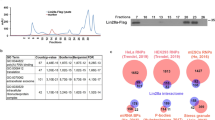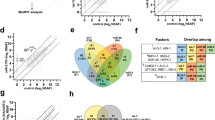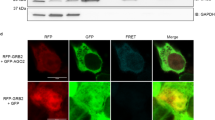Abstract
The High Mobility Group proteins HMGA1 are nuclear architectural factors that play a critical role in a wide range of biological processes. Since recent studies have identified the microRNAs (miRNAs) as important regulators of gene expression, modulating critical cellular functions such as proliferation, apoptosis and differentiation, the aim of our work was to identify the miRNAs that are physiologically regulated by HMGA1 proteins. To this purpose, we have analysed the miRNA expression profile of mouse embryonic fibroblasts (MEFs) carrying two, one or no Hmga1 functional alleles using a microarray (miRNA microarray). By this approach, we found a miRNA expression profile that differentiates Hmga1-null MEFs from the wild-type ones. In particular, a significant decrease in miR-196a-2, miR-101b, miR-331 and miR-29a was detected in homozygous Hmga1-knockout MEFs in comparison with wild-type cells. Consistently, these miRNAs are downregulated in most of the analysed tissues of Hmga1-null mice in comparison with the wild-type mice. ChIP assay shows that HMGA1 is able to bind regions upstream of these miRNAs. Moreover, we identified the HMGA2 gene product as a putative target of miR-196a-2, suggesting that HMGA1 proteins are able to downregulate the expression of the other member of the HMGA family through the regulation of the miR-196a-2 expression. Finally, ATXN1 and STC1 gene products have been identified as targets of miR-101b. Therefore, it is reasonable to hypothesize that HMGA1 proteins are involved in several functions by regulating miRNA expression.
This is a preview of subscription content, access via your institution
Access options
Subscribe to this journal
Receive 50 print issues and online access
$259.00 per year
only $5.18 per issue
Buy this article
- Purchase on Springer Link
- Instant access to full article PDF
Prices may be subject to local taxes which are calculated during checkout







Similar content being viewed by others
References
Ashar HR, Fejzo MS, Tkachenko A, Zhou X, Fletcher JA, Weremowicz S et al. (1995). Disruption of the architectural factor HMGI-C: DNA-binding AT hook motifs fused in lipomas to distinct transcriptional regulatory domains. Cell 82: 57–65.
Baldassarre G, Fedele M, Battista S, Vecchione A, Klein-Szanto AJ, Santoro M et al. (2001). Onset of natural killer cell lymphomas in transgenic mice carrying a truncated HMGI-C gene by the chronic stimulation of the IL-2 and IL-15 pathway. Proc Natl Acad Sci USA 98: 7970–7975.
Battista S, Fidanza V, Fedele M, Klein-Szanto AJ, Outwater E, Brunner H et al. (1999). The expression of a truncated HMGI-C gene induces gigantism associated with lipomatosis. Cancer Res 59: 4793–4797.
Berlingieri MT, Manfioletti G, Santoro M, Bandiera A, Visconti R, Giancotti V et al. (1995). Inhibition of HMGI-C protein synthesis suppresses retrovirally induced neoplastic transformation of rat thyroid cells. Mol Cell Biol 15: 1545–1553.
Chang AC, Janosi J, Hulsbeek M, de Jong D, Jeffrey KJ, Noble JR et al. (1995). A novel human cDNA highly homologous to the fish hormone stanniocalcin. Mol Cell Endocrinol 112: 241–247.
Chang AC, Jellinek DA, Reddel RR . (2003). Mammalian stanniocalcins and cancer. Endocr Relat Cancer 10: 359–373.
Chiappetta G, Avantaggiato V, Visconti R, Fedele M, Battista S, Trapasso F et al. (1996). High level expression of the HMGI (Y) gene during embryonic development. Oncogene 13: 2439–2446.
De Martino I, Visone R, Palmieri D, Cappabianca P, Chieffi P, Forzati F et al. (2007). The Mia/Cd-rap gene expression is downregulated by the HMGA proteins in mouse pituitary adenomas. Endocr Relat Cancer 14: 875–886.
Eisenhofer G, Huynh TT, Pacak K, Brouwers FM, Walther MM, Linehan WM et al. (2004). Distinct gene expression profiles in norepinephrine- and epinephrine-producing hereditary and sporadic pheochromocytomas: activation of hypoxia-driven angiogenic pathways in von Hippel-Lindau syndrome. Endocr Relat Cancer 11: 897–911.
Fedele M, Berlingieri MT, Scala S, Chiariotti L, Viglietto G, Rippel V et al. (1998). Truncated and chimeric HMGI-C genes induce neoplastic transformation of NIH3T3 murine fibroblasts. Oncogene 17: 413–418.
Fedele M, Battista S, Manfioletti G, Croce CM, Giancotti V, Fusco A . (2001). Role of the high mobility group A proteins in human lipomas. Carcinogenesis 22: 1583–1591. Review.
Fedele M, Battista S, Kenyon L, Baldassarre G, Fidanza V, Klein-Szanto AJ et al. (2002). Overexpression of the HMGA2 gene in transgenic mice leads to the onset of pituitary adenomas. Oncogene 21: 3190–3198.
Fedele M, Pentimalli F, Baldassarre G, Battista S, Klein-Szanto AJ, Kenyon L et al. (2005). Transgenic mice overexpressing the wild-type form of the HMGA1 gene develop mixed growth hormone/prolactin cell pituitary adenomas and natural killer cell lymphomas. Oncogene 24: 3427–3435.
Fedele M, Fidanza V, Battista S, Pentimalli F, Klein-Szanto AJ, Visone R et al. (2006). Haploinsufficiency of the Hmga1 gene causes cardiac hypertrophy and myelo-lymphoproliferative disorders in mice. Cancer Res 66: 2536–2543.
Foti D, Chiefari E, Fedele M, Iuliano R, Brunetti L, Paonessa F et al. (2005). Lack of the architectural factor HMGA1 causes insulin resistance and diabetes in humans and mice. Nat Med 7: 765–773.
Fujiwara Y, Sugita Y, Nakamori S, Miyamoto A, Shiozaki K, Nagano H et al. (2000). Assessment of Stanniocalcin-1 mRNA as a molecular marker for micrometastases of various human cancers. Int J Oncol 16: 799–804.
Fusco A, Fedele M . (2007). Roles of HMGA proteins in cancer. Nat Rev Cancer 12: 899–910. Review.
Galardi S, Mercatelli N, Giorda E, Massalini S, Frajese GV, Ciafrè SA et al. (2007). miR-221 and miR-222 expression affects the proliferation potential of human prostate carcinoma cell lines by targeting p27Kip1. J Biol Chem 282: 23716–23724.
Garber ME, Troyanskaya OG, Schluens K, Petersen S, Thaesler Z, Pacyna-Gengelbach M et al. (2001). Diversity of gene expression in adenocarcinoma of the lung. Proc Natl Acad Sci USA 98: 13784–13789.
Gerritsen ME, Soriano R, Yang S, Ingle G, Zlot C, Toy K et al. (2002). In silico data filtering to identify new angiogenesis targets from a large in vitro gene profiling data set. Physiol Genomics 10: 13–20.
Giannini G, Di Marcotullio L, Ristori E, Zani M, Crescenzi M, Scarpa S et al. (1999). HMGI(Y) and HMGI-C genes are expressed in neuroblastoma cell lines and tumors and affect retinoic acid responsiveness. Cancer Res 59: 2484–2492.
Giannini G, Kim CJ, Di Marcotullio L, Manfioletti G, Cardinali B, Cerignoli F et al. (2000). Expression of the HMGI(Y) gene products in human neuroblastic tumours correlates with differentiation status. Br J Cancer 83: 1503–1509.
Hebert C, Norris K, Scheper MA, Nikitakis N, Sauk JJ . (2007). High mobility group A2 is a target for miRNA-98 in head and neck squamous cell carcinoma. Mol Cancer 6: 5.
Holmes DI, Zachary IC . (2008). Vascular endothelial growth factor regulates stanniocalcin-1 expression via neuropilin-1-dependent regulation of KDR and synergism with fibroblast growth factor-2. Cell Signal 20: 569–579.
Irwin S, Vandelft M, Pinchev D, Howell JL, Graczyk J, Orr HT et al. (2005). RNA association and nucleocytoplasmic shuttling by ataxin-1. J Cell Sci 118: 233–242.
Ishibashi K, Imai M . (2002). Prospect of a stanniocalcin endocrine/paracrine system in mammals. Am J Physiol Renal Physiol 282: F367–F375.
Ismail RS, Baldwin RL, Fang J, Browning D, Karlan BY, Gasson JC et al. (2000). Differential gene expression between normal and tumor-derived ovarian epithelial cells. Cancer Res 60: 6744–6749.
Jellinek DA, Chang AC, Larsen MR, Wang X, Robinson PJ, Reddel RR . (2000). Stanniocalcin 1 and 2 are secreted as phosphoproteins from human fibrosarcoma cells. Biochem J 350: 453–461.
Johnson KR, Lehn DA, Reeves R . (1989). Alternative processing of mRNAs encoding mammalian chromosomal high-mobility-group proteins HMG-I and HMG-Y. Mol Cell Biol 9: 2114–2123.
Kent OA, Mendell JT . (2006). A small piece in the cancer puzzle: microRNAs as tumor suppressors and oncogenes. Oncogene 25: 6188–6196. Review.
Lai KP, Law AY, Yeung HY, Lee LS, Wagner GF, Wong CK . (2007). Induction of stanniocalcin-1 expression in apoptotic human nasopharyngeal cancer cells by p53. Biochem Biophys Res Commun 356: 968–975.
Lee Y, Samaco RC, Gatchel JR, Thaller C, Orr HT, Zoghbi HY . (2008). miR-19, miR-101 and miR-130 co-regulate ATXN1 levels to potentially modulate SCA1 pathogenesis. Nat Neurosci 11: 1137–1139.
Lee YS, Dutta A . (2007). The tumor suppressor microRNA let-7 represses the HMGA2 oncogene. Genes Dev 21: 1025–1030.
Liu CG, Calin GA, Meloon B, Gamliel N, Sevignani C, Ferracin M et al. (2004). An oligonucleotide microchip for genome-wide microRNA profiling in human and mouse tissues. Proc Natl Acad Sci USA 101: 9740–9744.
Manfioletti G, Giancotti V, Bandiera A, Buratti E, Sautiere P, Cary P et al. (1991). cDNA cloning of the HMGI-C phosphoprotein, a nuclear protein associated with neoplastic and undifferentiated phenotypes. Nucleic Acids Res 19: 6793–6797.
Martinez Hoyos J, Fedele M, Battista S, Pentimalli F, Kruhoffer M, Arra C et al. (2004). Identification of the genes up- and down-regulated by the high mobility group A1 (HMGA1) proteins: tissue specificity of the HMGA1-dependent gene regulation. Cancer Res 64: 5728–5735.
McCudden CR, Majewski A, Chakrabarti S, Wagner GF . (2004). Co-localization of stanniocalcin-1 ligand and receptor in human breast carcinomas. Mol Cell Endocrinol 213: 167–172.
Meister G, Landthaler M, Dorsett Y, Tuschl T . (2004). Sequence-specific inhibition of microRNA- and siRNA-induced RNA silencing. RNA 10: 544–550.
Melillo RM, Pierantoni GM, Scala S, Battista S, Fedele Mv, Stella A et al. (2001). Critical role of the HMGI(Y) proteins in adipocytic cell growth and differentiation. Mol Cell Biol 21: 2485–2495.
Meng F, Henson R, Wehbe-Janek H, Ghoshal K, Jacob ST, Patel T . (2007). MicroRNA-21 regulates expression of the PTEN tumor suppressor gene in human hepatocellular cancer. Gastroenterology 133: 647–658.
Miska EA . (2005). How microRNAs control cell division, differentiation, and death. Curr Opin Genet Dev 5: 563–568.
Negrini M, Ferracin M, Sabbioni S, Croce CM . (2007). MicroRNAs in human cancer: from research to therapy. J Cell Sci 120: 1833–1840.
Nishino J, Kim I, Chada K, Morrison SJ . (2008). Hmga2 promotes neural stem cell self-renewal in young but not old mice by reducing p16Ink4a and p19Arf expression. Cell 135: 227–239.
Olsen HS, Cepeda MA, Zhang QQ, Rosen CA, Vozzolo BL . (1996). Human stanniocalcin: a possible hormonal regulator of mineral metabolism. Proc Natl Acad Sci USA 93: 1792–1796.
Okabe H, Satoh S, Kato T, Kitahara O, Yanagawa R, Yamaoka Y et al. (2001). Genome-wide analysis of gene expression in human hepatocellular carcinomas using cDNA microarray: identification of genes involved in viral carcinogenesis and tumor progression. Cancer Res 61: 2129–2137.
Reeves R, Nissen MS . (1990). The AT DNA binding domain of mammalian high mobility group I chromosomal protein. A novel peptide motif for recognizing DNA structure. J Biol Chem 265: 8576–8582.
Scala S, Portella G, Fedele M, Chiappetta G, Fusco A . (2000). Adenovirus-mediated suppression of HMGI(Y) protein synthesis as potential therapy of human malignant neoplasias. Proc Natl Acad Sci USA 97: 4256–4261.
Schmittgen TD, Jiang J, Liu Q, Yang L . (2004). A high-throughput method to monitor the expression of microRNA precursors. Nucleic Acids Res 32: e43.
Schoenmakers EF, Wanschura S, Mols R, Bullerdiek J, Van den Berghe H, Van de Ven WJ . (1995). Recurrent rearrangements in the high mobility group protein gene, HMGI-C, in benign mesenchymal tumors. Nat Genet 10: 436–444.
Servadio A, Koshy B, Armstrong D, Antalffy B, Orr HT, Zoghbi HY . (1995). Expression analysis of the ataxin-1 protein in tissues from normal and spinocerebellar ataxia type 1 individuals. Nat Genet 10: 94–98.
Skinner PJ, Koshy BT, Cummings CJ, Klement IA, Helin K, Servadio A et al. (1997). Ataxin-1 with an expanded glutamine tract alters nuclear matrix-associated structures. Nature 389: 971–974.
Tallini G, Dal Cin P . (1999). HMGI(Y) and HMGI-C dysregulation: a common occurrence in human tumors. Adv Anat Pathol 6: 237–246.
Thanos D, Maniatis T . (1995). Virus induction of human IFN ß gene expression requires the assembly of an enhanceosome. Cell 83: 1091–1100.
Tsai CC, Kao HY, Mitzutani A, Banayo E, Rajan H, McKeown M et al. (2004). Ataxin 1, a SCA1 neurodegenerative disorder protein, is functionally linked to the silencing mediator of retinoid and thyroid hormone receptors. Proc Natl Acad Sci USA 101: 4047–4052.
Varghese R, Wong CK, Deol H, Wagner GF, DiMattia GE . (1998). Comparative analysis of mammalian stanniocalcin genes. Endocrinology 139: 4714–4725.
Visone R, Russo L, Pallante P, De Martino I, Ferraro A, Leone V et al. (2007). MicroRNAs (miR)-221 and miR-222, both overexpressed in human thyroid papillary carcinomas, regulate p27Kip1 protein levels and cell cycle. Endocr Relat Cancer 14: 791–798.
Wagner GF, Hampong M, Park CM, Copp DH . (1986). Purification, characterization, and bioassay of teleocalcin, a glycoprotein from salmon corpuscles of Stannius. Gen Comp Endocrinol 63: 481–491.
Wascher RA, Huynh KT, Giuliano AE, Hansen NM, Singer FR, Elashoff D et al. (2003). Stanniocalcin-1: a novel molecular blood and bone marrow marker for human breast cancer. Clin Cancer Res 9: 1427–1435.
Watanabe T, Ichihara M, Hashimoto M, Shimono K, Shimoyama Y, Nagasaka T et al. (2002). Characterization of gene expression induced by RET with MEN2A or MEN2B mutation. Am Pathol 161: 249–256.
Wong CK, Yeung HY, Mak NK, DiMattia GE, Chan DK, Wagner GF . (2002). Effects of dibutyryl cAMP on stanniocalcin and stanniocalcin-related protein mRNA expression in neuroblastoma cells. J Endocrinol 173: 199–209.
Yeung HY, Lai KP, Chan HY, Mak NK, Wagner GF, Wong CK . (2005). Hypoxia-inducible factor-1-mediated activation of stanniocalcin-1 in human cancer cells. Endocrinology 146: 4951–4960.
Yue S, Serra HG, Zoghbi HY, Orr HT . (2001). The spinocerebellar ataxia type 1 protein, ataxin-1, has RNA-binding activity that is inversely affected by the length of its polyglutamine tract. Hum Mol Genet 10: 25–30.
Zamore PD, Haley B . (2005). Ribo-gnome: the big world of small RNAs. Science 309: 1519–1524.
Zhou X, Benson KF, Ashar HR, Chada K . (1995). Mutation responsible for the mouse pygmy phenotype in the developmentally regulated factor HMGI-C. Nature 376: 771–774.
Acknowledgements
We thank Professor Stefano Volinia for miRNA microarray data analysis. This work was supported by grants from the Associazione Italiana Ricerca sul Cancro (AIRC), and the Ministero dell’Università e della Ricerca Scientifica e Tecnologica (MIUR). This work was supported from NOGEC-Naples Oncogenomic Center. We thank the Associazione Partenopea per le Ricerche Oncologiche (APRO) for its support.
Author information
Authors and Affiliations
Corresponding author
Additional information
Supplementary Information accompanies the paper on the Oncogene website (http://www.nature.com/onc)
Supplementary information
Rights and permissions
About this article
Cite this article
De Martino, I., Visone, R., Fedele, M. et al. Regulation of microRNA expression by HMGA1 proteins. Oncogene 28, 1432–1442 (2009). https://doi.org/10.1038/onc.2008.495
Received:
Revised:
Accepted:
Published:
Issue Date:
DOI: https://doi.org/10.1038/onc.2008.495
Keywords
This article is cited by
-
MicroRNA regulating stanniocalcin-1 is a metastasis and dissemination promoting factor in glioblastoma
Journal of Neuro-Oncology (2019)
-
MicroRNA-196a2 Biomarker and Targetome Network Analysis in Solid Tumors
Molecular Diagnosis & Therapy (2016)
-
PC-TraFF: identification of potentially collaborating transcription factors using pointwise mutual information
BMC Bioinformatics (2015)
-
Epidrug mediated re-expression of miRNA targeting the HMGA transcripts in pituitary cells
Pituitary (2015)
-
Identification of microRNAs involved in acute rejection and spontaneous tolerance in murine hepatic allografts
Scientific Reports (2014)



